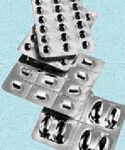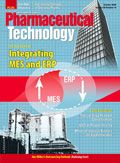To-Do List for 2009
Planning ahead will ensure successful efforts to improve packaging and packaging operations.
The new year is approaching fast, and it's not too early to think about goals for 2009. Although they differ from person to person and from job to job, three goals should be on every packaging team's list for 2009: improving the sustainability of its package or packaging line; identifying and implementing a container, material, machine, or practice that could improve its packaging process; and considering ways to make its packaging more consumer-friendly.

TETRA IMAGES/GETTY IMAGES
No matter which goal a team pursues, taking time to plan strategies and tactics in advance will help ensure that it is achieved.

Hallie Forcinio
Sustainability
It's important to periodically compare package designs with the reduce, reuse, recycle hierarchy that the Environmental Protection Agency advocates. For example, designers should ask whether the product's efficacy depends on the weight of the package. Even the smallest reduction in material thickness or weight can significantly decrease material costs, transportation costs, and greenhouse-gas emissions (see "Sustainability Surprises" in the September 2008 issue of Pharmaceutical Technology).
Designers should also ask whether the package must be as large as it is. Shrinking the size of a primary package, even by a millimeter or two, not only reduces weight, but also decreases the size of secondary and tertiary packaging. This reduction allows more product to be stacked per pallet, potentially making a difference throughout the supply chain.
Another criterion to evaluate is whether the package contains recycled content. If it does, perhaps more recycled content can be added. If recycled content is present, that fact should be noted on the package for consumers.

Plastic-identification recycling codes help consumers increase recycling rates. PETE is polyethylene terephthalate, HDPE is high-density polyethylene, V is vinyl, LDPE is low-density polyethylene, PP is polypropylene, and PS is polystyrene. (IMAGE IS COURTESY OF THE SOCIETY OF THE PLASTICS INDUSTRY.)
Fiber-based materials such as corrugated shipping cases, paperboard folding cartons, and paper-based labels, lidstock, and inserts or outserts should be made from certified material. Third-party certifications to the standards of organizations such as the Forest Stewardship Council and Sustainable Forestry Initiative confirm that the pulp used in the packagingproduction process comes from responsibly managed forests.
Packagers should seek to identify the biggest source of waste on the packaging line and discover how waste could be reduced. If preprinted material is the biggest source of waste, converting to a print-on-demand process might be cost-effective. Print-on-demand equipment is commonly available and includes various types of coders (e.g., laser, inkjet, and thermal-transfer) as well as label printers and applicators. Some units also can incorporate radiofrequency-identification-tag encoding modules to help drugmakers meet pedigree requirements.
If the package is not commonly recycled, packagers should find ways to improve its recycling rate. When recycling, consumers tend to focus on packaging for foods and beverages and overlook containers for other products, which are equally acceptable in many collection programs. Perhaps consumers should be reminded about the container's recyclability through a message on the label or a recycling logo on the base of the package.
The infrastructure supporting the collection of used packaging for recycling needs to be improved. Many trade associations are working to boost recycling rates. In addition, companies such as Estée Lauder's Aveda and TerraCycle have established creative programs to keep packaging material out of landfills.
In cooperation with schools and its network of stores and salons, Aveda has organized a program to collect polypropylene closures from water, carbonated soft drink, detergent, and shampoo bottles. The program is designed to reduce litter, pollution, and the chance that birds, seals, turtles, and other wildlife might ingest the closures. The collected parts will be used to make new caps such as the 100% recycled-content dispensing closure Aveda began using in September 2008 for its new "Limited Edition Vintage Clove" shampoo.
Supported by several brand owners, TerraCycle has organized a grassroots recycling network that collects empty drink pouches and cookie-package wrappers. TerraCycle cleans the material and uses it to make consumer products such as totes, pencil cases, umbrellas, and shower curtains.
Reusing distribution packaging is another sustainable strategy. Coldchain Technology Services (Spring Branch, TX), a provider of logistics and consulting services for temperaturesensitive shipments, discovered that reusable insulated shippers quickly pay for themselves. Recyclable components also enhance the packaging system's sustainability profile ("Greenbox" insulated shipper, Entropy Solutions, Minneapolis, MN, see "Containers Insulate Companies from Product Loss" in the March 2008 issue of Pharmaceutical Technology).
It is important for a sustainable package to identify itself. Consumers, retailers, distributors, wholesalers, pharmacists, and doctors want to know about the package and its environmental impact. Claims of sustainability should include supporting data. For example, a statement that a package is 20% lighter and reduces greenhouse- gas emissions by 16,000 tons per year is much more meaningful than a vague claim about an "improved," "more sustainable" or "new lightweight package."
Improvements to packages and the packaging line
Packaging and packaging-line improvements begin with identifying the source of the greatest waste, inefficiency, or expense and looking for a better alternative. The alternative could be a simple, inexpensive fix such as arranging just-in-time delivery of packaging components, or it might require capital investment.
Trade shows and conferences provide excellent opportunities to study design options and discover new ideas. Pharmaceutical packaging- related trade shows scheduled in 2009 include INTERPHEX (Mar. 17–19 at the Jacob K. Javits Convention Center in New York), the triennial NPE2009 (June 22–26 at McCormick Place in Chicago), and Pack Expo Las Vegas (Oct. 5–7 at the Las Vegas Convention Center in Las Vegas, NV).
The pharmaceutical-industry trade show INTERPHEX, which is colocated with the Pharma MedDevice show, features numerous exhibitors dedicated to pharmaceutical packaging. In addition, a conference program offers information about productivity improvement, automation, isolator technology, counterfeit prevention, and pedigree solutions.
An all-encompassing look at what's new in plastics will be presented at the NPE2009 International Plastics Showcase, organized by the Society of the Plastics Industry. With more than 2000 exhibits, it's a must-see event for anyone looking for innovations in plastic packaging, especially because it only occurs once every three years.
Pack Expo Las Vegas is held in oddnumbered years and alternates with Pack Expo International. Pack Expo Las Vegas is a machinery-oriented show and will be the year's best opportunity to see packaging equipment in action. Despite the dominance of machines, containers and materials are well represented in their own pavilion and at the colocated Converting and Package Printing Expo. A concurrent conference at Pack Expo gives attendees the opportunity to hear experts discuss a host of subjects organized according to tracks such as sustainability, upgrading operations, and brand protection.
In addition, several trade associations and educational organizations host conferences designed to help pharmaceutical packaging personnel improve pharmaceutical packages and packaging lines. These groups include the Institute of Validation Technology, the Parenteral Drug Association, Healthcare Compliance Packaging Council (HCPC), the International Society for Pharmaceutical Engineering, BIOTAQ, Compliance Online, and SWE Enterprises.
Finally, a great deal of research can be done on the Internet. Google is always a good starting point or final double-check. However, packaging- or pharmaceutical-industry-oriented websites generally deliver searches with more targeted results. Packaging websites include those of events such as Pack Expo and publications such as Packaging World, Packaging Digest, and Packaging Machinery Technology. Informative pharmaceutical websites include those of Pharmaceutical Technology and Pharmaceutical and Medical Packaging News.
Consumer-friendly design
Consumer-friendly design should always be near the top of the list of required features for pharmaceutical packaging. Today's rapidly growing population of people older than 60, the significant percentage of people with a limited ability to read English, and the high rate of noncompliance make it more important than ever to provide packages that open and reclose easily and help consumers take the proper dose at the proper time. In addition, packages must still provide child resistance to prevent accidental ingestion by toddlers and babies.
Winners of HCPC's annual "Compliance Package of the Year" competition offered creative ideas. Several winners used a wallet-pack concept, including this year's top-prize winner: a lockable package for "Glipizide," a bloodglucose lowering drug from Watson Pharmaceuticals (Corona, CA). A removable key card unlocks and locks the package. The card can be left in place to simplify access in households without children ("Key.In" package, Nosco, Waukegan, IL). Another wallet pack, this one for Pfizer's (New York) "Champix Starting Therapy" smoking- cessation treatment, captured the first runner-up spot. Designed for the Mexican market, the four-panel wallet card neatly accommodates a patient leaflet and holds a two-week supply of the drug.
The second runner-up in the HCPC competition, the "Effexor XR Flow Wrap" titration package from Wyeth (Madison, NJ), ensures that patients receive the Effexor antidepressant with a medication guide, as mandated by the US Food and Drug Administration. The packaging consists of blister-card and secondary-pouch packaging, plus a carton (contract packaging service, Sharp, Allentown, PA).
A fourth prize, awarded in the "Innovative Design" category that recognizes packages that are not yet commercial, honored a child-resistant bottle and closure. A mechanism in the push-and-turn closure dispenses one dose at a time and also lines up a dial to indicate dosage day and time ("NextBottle," One World Design and Manufacturing Group, Warren, NJ).
Winners of the HCPC competition will be featured in the Showcase of Packaging Innovations at Pack Expo International on Nov. 9–13, 2008 at McCormick Place in Chicago. With more than 300 award-winning packages from around the world, the Showcase, which is sponsored by Dow Chemical (Midland, MI), provides the perfect opportunity to gather ideas for new pharmaceutical packages.
Hallie Forcinio is Pharmaceutical Technology's Packaging Forum editor, 4708 morningside Drive, Cleveland, OH 44109, tel. 216.351.5824, fax 216.351.5684, editorhal@cs.com

Pharmaceutical Tariffs Are Imminent: How Industry is Bracing for Impact
April 16th 2025On April 14, 2025, the Trump Administration launched a national security-driven investigation into pharmaceuticals, a move that will likely result in tariffs being placed on pharmaceutical drugs, ingredients, and other components that are imported from outside of the United States.